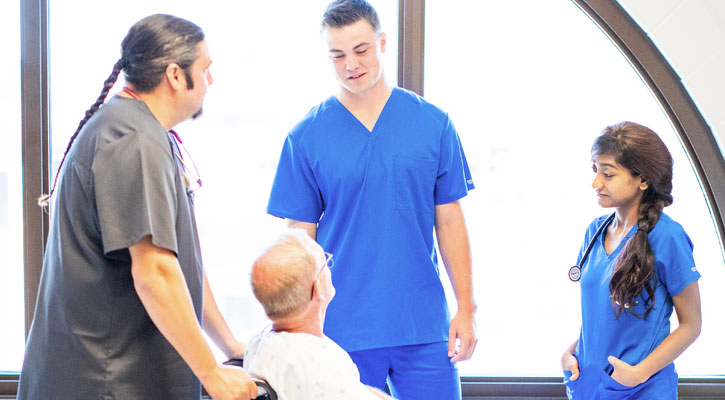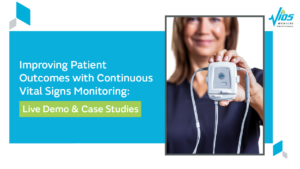
How Vios Remote Monitoring Services (RMS) Reduces the Burden of Clinical Staff in Your Healthcare System
Healthcare clinicians are often portrayed as heroes in the community, and rightly so.
The work they do, the care they provide and the responsibilities they take upon their shoulders—it’s all worthy of admiration and praise. At Vios, we feel it’s also worthy of something else: our help.
Across the country, healthcare staff sizes are shrinking while the duties placed upon clinicians grow. Healthcare facilities are counting on clinicians to do more and more each shift with fewer team members to count on for support.
It’s time to change the clinician workload equation allowing them to put more focus on the patient. This can be accomplished with Remote Monitoring Services (RMS).
An Around-the-Clock Vital Signs Monitoring System
What is remote patient monitoring?
To understand Remote Monitoring Services and remote patient monitoring, we need to take a moment to explain its foundation: the Vios Monitoring System (VMS).
The Vios Monitoring System (VMS) is a wireless, FDA-cleared, internet of things (IoT) patient monitoring solution designed to improve patient outcomes and reduce costs. The VMS enables clinicians to continuously monitor a patient’s 7-lead ECG, heart rate, respiratory rate, pulse rate, SpO2 and posture. It also accommodates the manual entry and input of blood pressure and body temperature data. Healthcare facilities are able to leverage their existing IT infrastructures and deploy the solution throughout their various care settings.
With the VMS, healthcare facilities are able to deliver improved patient care. What’s more, they can easily redeploy beds as needed or re-assign care units in times of a health emergency.
But there’s something else that sets the Vios Monitoring System apart. We call it Remote Monitoring Services (RMS).
No matter the time of day, staff workload or situation, RMS ensures each and every patient is monitored around the clock. Remote Monitoring Services provides real-time access and visibility into each patient’s vital sign data. This means Vios is in the patient’s room even when your clinicians can’t be.
By being present, we’re able to respond to alarms and alerts as needed with almost no delay.
Delivering Intentional Care With Remote Patient Monitoring
Something great happens when clinicians aren’t burdened with the task of checking physiologic monitoring systems in person. Suddenly, they’re able to deliver intentional care instead of documentative care.
Rather than checking and recording a patient’s condition, they can respond to it. It’s the difference between walking in to discover that a patient has an accelerated heart rate and walking into the room with a method to address the accelerated rate.
How does this happen? With Remote Monitoring Services. How does remote patient monitoring work? It identifies any change in vital signs and digitally notifies a clinician who is likely handling other tasks in the care unit. Upon receiving notification, the clinician knows what the issue is, and can take steps to address the scenario.
Being notified of a change in a patient’s condition before the clinician enters the room is a game-changer. It means clinicians arrive informed, prepared and ready to act. It’s a powerful difference that can improve patient care.
When Caring for a Patient, Every Moment Matters
Why is remote patient monitoring important? Negative changes in a patient’s condition can be a slow decline or a rapid drop. When it’s a rapid drop, there’s no time for delays or lost opportunities. Depending on the scenario, a few seconds can make a significant difference.
With a traditional patient monitoring system, changes in a patient’s vital signs may go unnoticed at first if the clinicians are with other patients or there’s no one at the central monitoring station. When a patient is connected to a Vios Monitoring System, it’s supported by Remote Monitoring Services.
Information is transmitted in real-time, as fast as possible allowing clinicians to respond. Having Remote Monitoring Services means there’s rarely a lapse between a patient’s change in condition and clinician notification.
Even if and when staff is busy in other areas or with other tasks, the Vios Monitoring team will catch the change and alert the clinicians to take action.
New Possibilities to Improve Care
The Vios Monitoring System, supported by Remote Monitoring Services, gives hospitals and other healthcare facilities or care units the opportunity to rethink how they deliver care and assign tasks. Whether it’s used as a precautionary backup or a reliable tool to reduce staff workloads, it opens new doors to improving efficiency and patient health.
RMS is not intended to reduce the time spent with patients, it’s about improving the time with patients. RMS helps clinicians make well-informed care decisions. The RMS is an asset that clinicians will come to find an invaluable resource that helps them to improve patient care.
Interested in learning more? Connect with Vios and find out how your facility can bring the power of the Vios Remote Monitoring to its care units.
We’re ready to help you to improve patient care and reduce staff burden.



